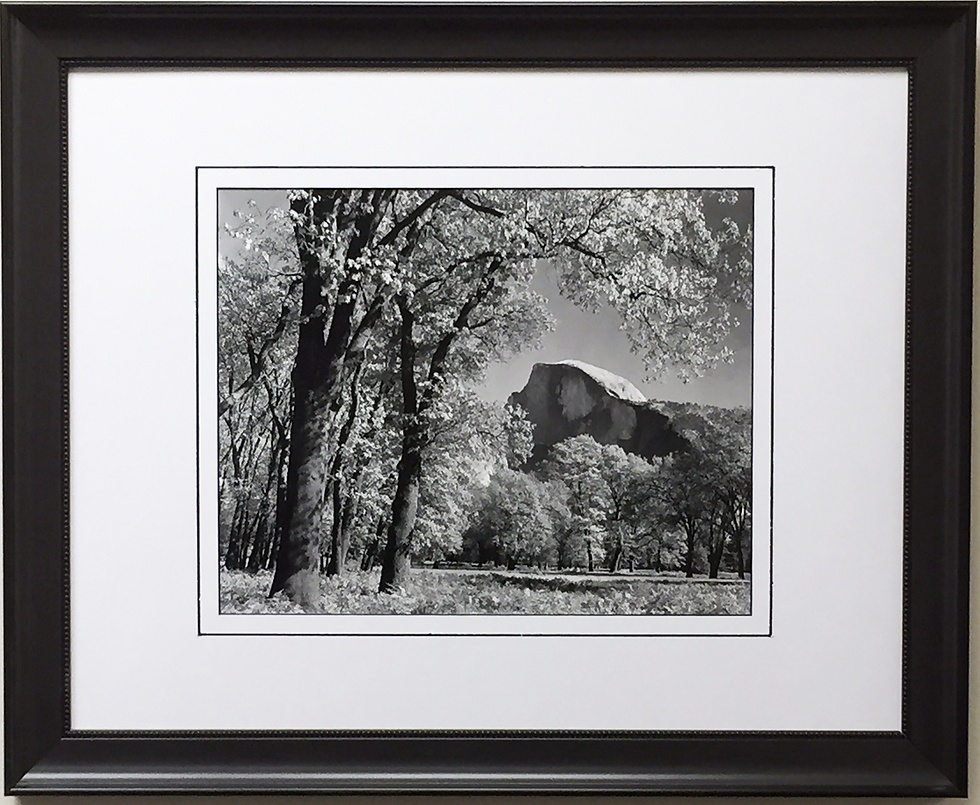Ansel Adams - "Half Dome, Oak Trees, Autumn"
Yosemite National Park, California, 1938
This is a
Brand new beautifully custom framed - in a top quality black wood frame
Matted with a v-groove cut in the off-white mat
Ready to hang (hooks and wire already on the artwork)
Offset lithograph from the most famous photographer of all time
The framed artwork measures approx. 19" x 23"
FRAMING ALONE IS WORTH OVER $200
Adams, Ansel (1902 — 1984) - photographer and environmentalist, was born in San Francisco, California.
His black-and-white landscape photographs of the American West, especially Yosemite National Park, have been widely reproduced on calendars, posters, and books
In the 1920s Adams was spending as much time as he could in the Sierra Nevada, hiking, exploring, and taking photographs. He became friendly with leaders of the Sierra Club, had photos and writings printed in the club's official publication, and became more involved with the conservation movement. He even met his wife, Virginia Best, in Yosemite. They were married in 1928 and had two children.
Photography career
Ansel Adams gave up on the piano and decided to become a full-time professional photographer at about the time that some of his work was published in limited edition collections, such as Parmelian Prints of the High Sierras (1927) and Taos Pueblo (1930), with text written by Mary Austin. His first important one-man show was held in San Francisco in 1932 at the M. H. de Young Memorial Museum.
Adams went on to open the Ansel Adams Gallery for the Arts. He also taught, lectured, and worked on advertising assignments in the San Francisco area. During the 1930s he also began his extensive publications on methods of photography, insisting throughout his life on the importance of careful craftsmanship. In 1936 Alfred Stieglitz (1864–1946) gave Adams a oneman show in his New York gallery—only the second time the work of a young photographer was exhibited by Stieglitz.
In 1937 Adams moved to Yosemite Valley close to his major subject and began publishing a stream of volumes, including Sierra Nevada: The John Muir Trail(1938), Illustrated Guide to Yosemite Valley (1940), Yosemite and the High Sierra (1948), and My Camera in Yosemite Valley (1949).
New ideas on photography
In 1930 Adams met the famous photographer Paul Strand (1890–1976) while they were working in Taos, New Mexico, and the man and his work had a lasting effect on Adams's approach to photography. Strand encouraged Adams to change his approach from a soft expression of subjects to a much clearer, harder treatment, so-called "straight photography." This idea was further reinforced by his association with the short-lived, but important, group of photographers known as f/64 (referring to the lens opening which guarantees a distinct image), which included Edward Weston (1886–1958) and Imogen Cunningham (1883–1976). This group helped the development of photography as a fine art.
In one sense Ansel Adams's work is an extensive record of what is still left of the wilderness, the shrinking untouched part of the natural environment. Yet to see his work only as photographic images is to miss the main point that he tried to make: without a guiding vision, photography is not necessarily an important activity. The finished product, as Adams saw it, must be thought up before it can be executed. With nineteenth-century artists and philosophers (seekers of wisdom) he shared the belief that this vision must be inspired by life on earth. Photographs, he believed, were not taken from the environment but were madeinto something greater than themselves.
Ansel Adams died on April 22, 1984. During his life he was criticized for photographing rocks while the world was falling apart. He responded by suggesting that "the understanding of the … world of nature will aid in holding the world of man together."
Mountain, oak tree, Photography
Ansel Adams "Half Dome Oak Trees Autumn"
Unsigned

